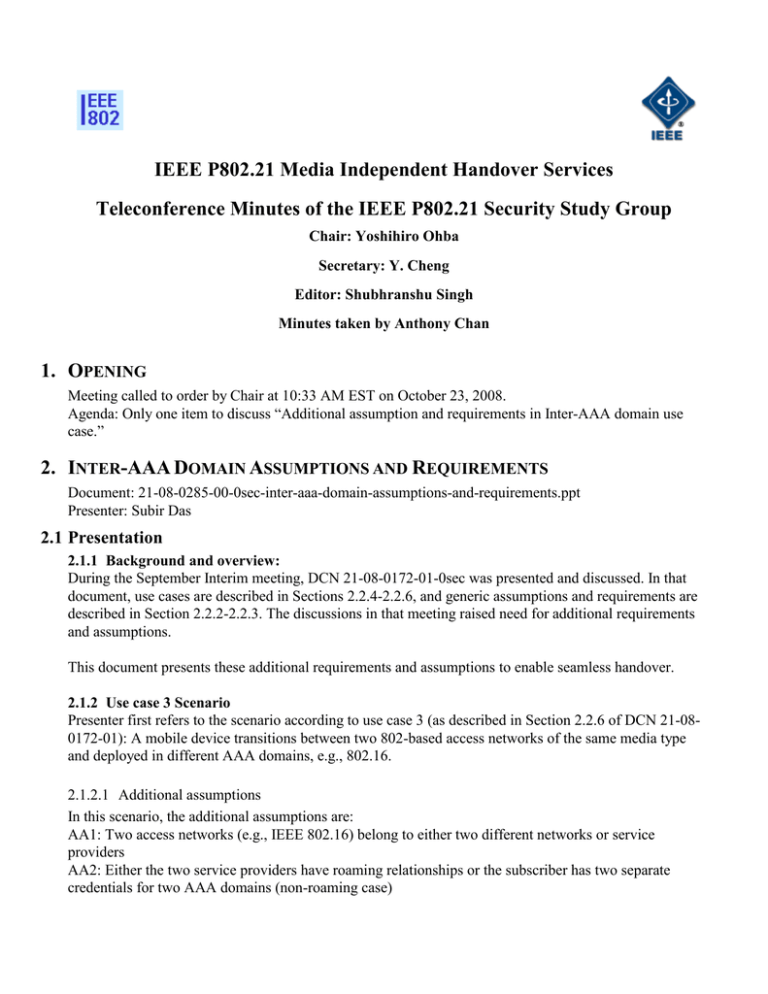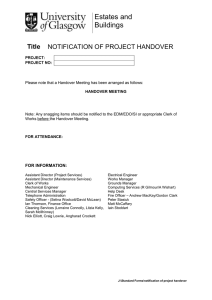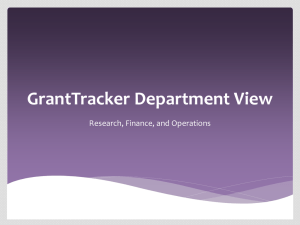IEEE P802.21 Media Independent Handover Services
advertisement

IEEE P802.21 Media Independent Handover Services Teleconference Minutes of the IEEE P802.21 Security Study Group Chair: Yoshihiro Ohba Secretary: Y. Cheng Editor: Shubhranshu Singh Minutes taken by Anthony Chan 1. OPENING Meeting called to order by Chair at 10:33 AM EST on October 23, 2008. Agenda: Only one item to discuss “Additional assumption and requirements in Inter-AAA domain use case.” 2. INTER-AAA DOMAIN ASSUMPTIONS AND REQUIREMENTS Document: 21-08-0285-00-0sec-inter-aaa-domain-assumptions-and-requirements.ppt Presenter: Subir Das 2.1 Presentation 2.1.1 Background and overview: During the September Interim meeting, DCN 21-08-0172-01-0sec was presented and discussed. In that document, use cases are described in Sections 2.2.4-2.2.6, and generic assumptions and requirements are described in Section 2.2.2-2.2.3. The discussions in that meeting raised need for additional requirements and assumptions. This document presents these additional requirements and assumptions to enable seamless handover. 2.1.2 Use case 3 Scenario Presenter first refers to the scenario according to use case 3 (as described in Section 2.2.6 of DCN 21-080172-01): A mobile device transitions between two 802-based access networks of the same media type and deployed in different AAA domains, e.g., 802.16. 2.1.2.1 Additional assumptions In this scenario, the additional assumptions are: AA1: Two access networks (e.g., IEEE 802.16) belong to either two different networks or service providers AA2: Either the two service providers have roaming relationships or the subscriber has two separate credentials for two AAA domains (non-roaming case) AA3: For non-roaming case, target authenticators may only be reachable via IP connectivity from the source radio 2.1.2.2 Additional requirements The additional requirements are: When roaming relationship exists, the security context may be shared between the two AAA domains For non-roaming case, the mobile device shall conduct an authentication prior to handover to the target network using the credential for that target network; the security context cannot be shared between the two AAA domains 2.1.3 Use case 2 Scenario There was not enough time to go over the slides for the scenario according to use case 2 (as described in Section 2.2.6 of DCN 21-08-0172-01). Presenter mentioned that they are largely similarity to that in use case 3. 2.2 Discussions 2.2.1 Clarification: Non-roaming here refers to the lack of service agreement to handover, although this term has also been used to refer to that of a mobile device in its home network. Credential here refers to long-term credential. There are 2 separate cases in AA2: with service agreement and without service agreement. 2.2.2 Roaming case (with service agreement) In today’s network, handover is controlled by the network and is based on service agreement between the service providers. Roaming is well understood, and the group agrees that this roaming case is relevant. 2.2.3 Non-Roaming case (without service agreement) The assumptions and requirements are theoretically sound. Yet, it is not agreed upon whether this case is applicable. That is, is there a real / practical use case for a mobile to move its session from one SP’s network to another SP’s network without service agreement between the 2 SPs. 2.2.3.1 Use case. Presenter reiterated that the non-roaming case is based on the use case 2/3 in DCN 21-08-0172-01. It is questioned whether such a non-roaming case really exists. If it does not currently exist, will it be needed in future so that we have to include it into standard? The discussions dig deeper into the non-roaming case to understand exactly what happens: 2.2.3.2 Client or Network initiated? Consider Mobile device initiated handover. 2.2.3.3 One 802.16 interface Consider that the mobile device has one 802.16 interface, and it is connected to the network of one service provider. 2.2.3.4 One IP address The interface has one IP address to connect to one network. Using the connection to this network, it uses IP to find another network to perform authentication, as stated in AA3. 2.2.3.5 Handover The client moves its session from one network to another network without change of IP address. To be more explicit, we use MIP terminology to say that the session moves without change of HoA although CoA may change. 2.2.3.6 Network configuration It is asked whether presenter is referring to a network configuration with ASN1 and ASN3 both under one CSN1. The device connected to ASN1 (belonging to SP1) is moving to ASN3 (belonging to SP2) with HoA obtained from CSN1. Then SP2 is only providing (3rd party) access to ASN3. Presenter is not referring to this configuration. The following network configuration in WiMAX network is then used to facilitate the discussion: SPa network SPb network CSNa / \ / \ CSNb / \ / \ / \ ASN1 ASN2 / \ ASN3 ASN4 2.2.3.7 Relationship between the 2 networks The 2 SPs have no service agreement to roam between them, although there is connectivity between the 2 networks: CSNa and CSNb. It is asked where the device has obtained its IP address before handover. If the device obtains its IP address from the network it is connected to, it is not clear how and why it moves its session to another network. So the only possibility to investigate the applicability of such a case is that it uses its credentials with SPa and the mobility service from SPa to obtain its HoA from CSNa while it uses its separate credentials with SP2 to attach to ASN3/ASN4 from where it obtains its CoA. Then presenter claims that it is possible to move from ASN3/4 to ASN1/2. Further discussions are needed. 3. CLOSING (CHAIR) 3.1 Action items With the roaming case being agreed upon, Subir will state/clarify the roaming case with its assumptions and requirements again. Subir and Ajay may continue discussion offline on the non-roaming case to make a contribution to present at the November Plenary meeting. Other contributions to the November meeting are welcome. Chair will find out the deadline to upload contributions. 3.2 The discussions are very helpful. Thanks to everyone. Meeting adjourns around 12:27PM EST. 4. ATTENDEES NAME Yoshihiro Ohba Da Peng Liu Lily Chen Subir Das Ashutosh Dutta Ajay Rajkumar Anthony Chan AFFILIATION Toshiba China Mobile NIST Telcordia Technologies Telcordia Technologies Alcatel-Lucent Huawei Technologies




